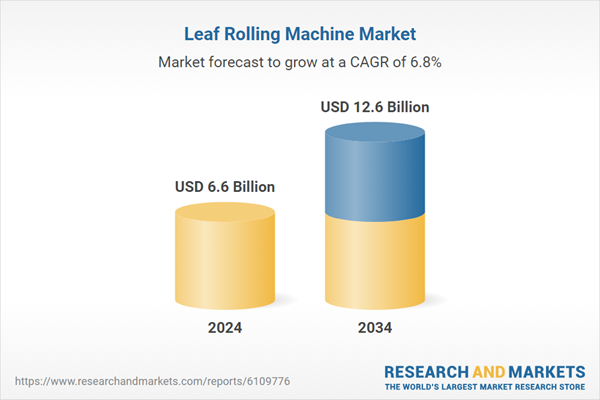Initiatives such as robotics funding and pilot incentives are driving OEM innovation and scaling, including among makers of leaf rolling machines. These supportive programs are fostering rapid experimentation with intelligent manufacturing tools, enabling OEMs to integrate automation, data analytics, and IoT features into rolling systems. Government-backed grants and subsidies are lowering the cost of innovation and de-risking the adoption of advanced machinery for manufacturers. As a result, companies are investing in prototyping modular designs and launching pilot installations in both large-scale and smallholder operations. This external support is also accelerating time-to-market for next-gen machines with capabilities such as adaptive rolling precision, remote diagnostics, and energy-efficient operation.
Rotary rolling machines pulled segment in USD 2.8 billion in revenue in 2024 and are expected to reach USD 5.1 billion by 2034. Designed for continuous, high-throughput processing, they serve large-scale producers of cigars, tea, cannabis pre-rolls, and herbal wraps. These machines ensure consistent quality at thousands of units per hour and can handle diverse leaf materials without needing major modifications, giving manufacturers operational flexibility and strong returns on investment.
The automatic machine segment generated USD 2.7 billion in 2024 and held a 40.8% share. Fully automatic leaf rolling systems reduce labor needs and human error-particularly valuable in developed regions where wage growth and labor shortages are critical issues. These systems produce uniform roll dimensions, weights, and densities, helping manufacturers meet strict regulatory and brand standards. Their scalability enables businesses to adapt to demand fluctuations without sacrificing consistency.
U.S. Leaf Rolling Machine Market was valued at USD 1.07 billion in 2024 and is projected to grow at a CAGR of 6.4% from 2025 to 2034. The rapid expansion of legal recreational and medical cannabis across more than 30 states has driven strong interest in automated pre-roll production equipment. Licensed producers are investing in fully automatic machines to meet GMP standards, reduce labor dependency, and deliver consistent pre-packaged products. Tobacco and emerging herbal wellness brands are similarly updating production lines with rotary and automatic rollers integrated with Industry 4.0 features. Focus areas such as batch-level traceability, cleanroom compatibility, and robotic handling are shifting procurement decisions toward highly data-driven, technology-rich machinery.
Major players in the Global Leaf Rolling Machine Market include: GreenBroz Inc., Fuzhou KeShiDa Machinery Co., Ltd., Hubei Pinyang Technology Co., Ltd., Shenzhen Hana Tech Co., Ltd., Teamachinerys (ZC Machinery), STM Canna, Quanzhou Deli Agroforestrial Machinery Co., Ltd., Quanzhou Wit Tea Machinery Co., Ltd., Hangzhou LOM Technology Co., Ltd., Langfang ShengXing Food Machinery Co., Ltd., Tobaccoandmachines, Zhengzhou Jawo Machinery Co., Ltd., and Zhengzhou Wenming Machinery Co., Ltd. In this competitive landscape, leading manufacturers are emphasizing several strategic moves.
First, they are investing heavily in Industry 4.0 integration-such as real-time data platforms and OPCUA compliance-to provide advanced traceability and quality control. Second, firms are expanding their portfolios to offer customizable solutions that handle multiple leaf types (tobacco, cannabis, tea), giving customers operational flexibility. Third, companies are securing partnerships and pilot program funding with agricultural and government bodies to accelerate automation adoption and secure early-stage wins in emerging markets.
Comprehensive Market Analysis and Forecast
- Industry trends, key growth drivers, challenges, future opportunities, and regulatory landscape
- Competitive landscape with Porter’s Five Forces and PESTEL analysis
- Market size, segmentation, and regional forecasts
- In-depth company profiles, business strategies, financial insights, and SWOT analysis
This product will be delivered within 2-4 business days.
Table of Contents
Companies Mentioned
- Fuzhou KeShiDa Machinery Co., Ltd.
- GreenBroz Inc.
- Hangzhou LOM Technology Co., Ltd.
- Hubei Pinyang Technology Co., Ltd.
- Langfang ShengXing Food Machinery Co,.Ltd
- Quanzhou Deli Agroforestrial Machinery Co., Ltd.
- Quanzhou Wit Tea Machinery Co., Ltd.
- Shenzhen Hana-Tech Co., Ltd.
- STM Canna
- Teamachinerys (ZC Machinery)
- Tobacco And Machines
- Zhengzhou Jawo Machinery Co., Ltd.
- Zhengzhou Wenming Machinery Co., Ltd.
Table Information
| Report Attribute | Details |
|---|---|
| No. of Pages | 150 |
| Published | June 2025 |
| Forecast Period | 2024 - 2034 |
| Estimated Market Value ( USD | $ 6.6 Billion |
| Forecasted Market Value ( USD | $ 12.6 Billion |
| Compound Annual Growth Rate | 6.8% |
| Regions Covered | Global |
| No. of Companies Mentioned | 13 |









